RICHARD’S “CANADA AM” REVIEWS FOR JUNE 12 WITH BEVERLY THOMSON.
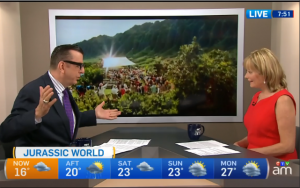 Richard’s “Canada AM” reviews for “Jurassic World,” “Slow West” and “Me and Earl and the Dying Girl.”
Richard’s “Canada AM” reviews for “Jurassic World,” “Slow West” and “Me and Earl and the Dying Girl.”
Watch the whole thing HERE!
 Richard’s “Canada AM” reviews for “Jurassic World,” “Slow West” and “Me and Earl and the Dying Girl.”
Richard’s “Canada AM” reviews for “Jurassic World,” “Slow West” and “Me and Earl and the Dying Girl.”
Watch the whole thing HERE!
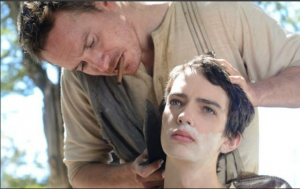 “Slow West” looks like a classic western, but there’s little here, other than the landscape, some gunfights and the campfire coffee, that John Wayne would recognize.
“Slow West” looks like a classic western, but there’s little here, other than the landscape, some gunfights and the campfire coffee, that John Wayne would recognize.
Scottish 16-year-old Jay Cavendish (Kodi Smit-McPhee) is a man on a mission. He’s crossing the rugged 1870s American frontier in search of his true love, Rose (Caren Pistorius). Aiding him—and keeping him alive—on the trip is outlaw Silas Selleck (Michael Fassbender). “You need chaperoning,” he says of the young man, whose main guide up until this point was a book called “Ho! For the West.” What Jay doesn’t know is that he’s not the only one on the hunt for Rose and her father (Rory McCann). There is a price on their heads and bounty hunters are starting to circle.
Literate and stylish, “Slow West” is an unconventional western, one that is more interested in taking its time to tell its slight story than amping up the action. It’s a love story, a mentor’s tale and an anthropological look into American history (even though it was shot in New Zealand).
First time feature director John Maclean is clearly more interested in setting the scene and exploring the characters than anything else, but he does stage two terrifically tense gunfights, the staple of any good western. The first, in a general store, is quiet, violent and memorable. The second, which provides’ the film’s climax, is a classic shootout, complete with bad men hiding in a cornfield and a bullet riddled farmhouse. Both are edge of your seat and are crucial to the story. There’s nothing superfluous in either scene.
“Slow West” features a surprisingly fleet footed and funny performance from Fassbender and a great villainous turn by Ben Mendelsohn to buoy the dramatic heft of the story.
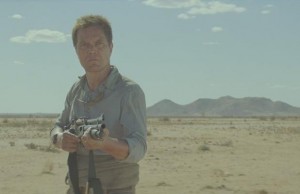 “Young Ones” mixes sci fi, dystopia and some young stars but unlike recent stories told in a similar vein there are no sorting ceremonies, or mazes or Hunger Games. Instead it’s a futuristic tale about the simple stuff—land, water and power.
“Young Ones” mixes sci fi, dystopia and some young stars but unlike recent stories told in a similar vein there are no sorting ceremonies, or mazes or Hunger Games. Instead it’s a futuristic tale about the simple stuff—land, water and power.
Set in the near, dusty future. Water has become the world’s most precious commodity, a resource worth killing for. When we first meet Ernest Holm (Michael Shannon) that’s exactly what he’s doing. He guns down two bandits who try and access his well, the well he uses to hydrate his son and daughter, Jerome (Kodi Smit McPhee) and Mary (Elle Fanning). They lead a rough frontier life, which could be improved by the pipeline construction bigwig Caleb (Robert Hobbs) is building. In an effort to grab Ernest’s land, Mary’s power hungry boyfriend Flem Lever (Nicholas Hoult) helps divert the pipeline, but his assistance comes with a heavy price.
“Young Ones” is divided into three chapters, detailing Ernst’s struggles, Flem’s rise and Jerome’s reckoning. It’s primal stuff, stylishly shot and featuring good performances, particularly from Shannon whose battle with his inner demons is vivid and the most interesting part of the film, but is let down by a weak story. “Chinatown,” the great cinematic water war movie, never let the story get in the way of the characters or vice versa, but “Young Ones” takes an interesting premise that could possess great, almost Shakespearean characters fighting over the most necessary of all human needs and muddles the two so that both fall flat.
It’s an ambitious attempt at redefining what has become of the dystopian genre, but despite some good work from Shannon it’s a bland, bone dry movie.
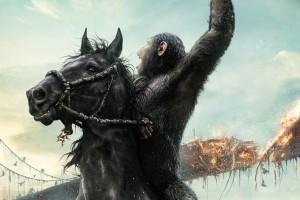 “Dawn of the Planet of the Apes” is a different kind of blockbuster. It has all the elements of the usual summer fare— it’s a sequel, things blow up and, if that wasn’t enough, also features an ape on horseback —but it takes more risks than Optimus Prime could shake Michael Bay at. About half of it is done in ape sign language (with subtitles) and it’s not chock-a-block with action. Instead it takes time building characters and motivations so when the wild ape-on-human action begins it feels earned and it feels epic.
“Dawn of the Planet of the Apes” is a different kind of blockbuster. It has all the elements of the usual summer fare— it’s a sequel, things blow up and, if that wasn’t enough, also features an ape on horseback —but it takes more risks than Optimus Prime could shake Michael Bay at. About half of it is done in ape sign language (with subtitles) and it’s not chock-a-block with action. Instead it takes time building characters and motivations so when the wild ape-on-human action begins it feels earned and it feels epic.
Set ten years after Rise of the Planet of the Apes saw Caesar (Andy Serkis) break free from a San Fransisco primate sanctuary and start an ape uprising, the middle-aged chimpanzee is the leader of a large population of genetically evolved apes. Most of humankind was wiped out by a pandemic of ALZ-113—a “simian flu” virus that speeds up the rebuilding of brain cells in apes but is deadly to humans—but when a small band of humans scout a water source near the ape camp a monkey wrench is thrown into the fragile peace between homo sapiens and simians is threatened. “Apes do not want war,” says Caesar, but a battle—gorilla warfare?—for control is inevitable.
To riff off of the old Superman tagline, “You will believe an ape can speak.” The special effects are amazing, but beyond the pixel manipulation that brings Caesar and company to vivid life, there are remarkable performances that, for lack of a better phrase, humanize the apes. These aren’t the erudite apes of the Roddy McDowell era, with vocabularies that would impress even Conrad Black, but simian characters that behave somewhere midway between pure instinct and higher intelligence.
Gary Oldman, as a human protectionist, Jason Clarke as the human who reaches out to Caesar in the spirit of friendship and cooperation and Keri Russell as his resourceful wife are all terrific, but I went bananas for these apes.
Beyond the flashy special effects and Serkis’s understated but powerful performance—this is the kind of performance that could convince the Academy to consider “motion capture” acting for inclusion in the Oscar acting categories—is a smart movie about race, gun usage and xenophobia. Its masked in allegory and, well, a story about talking apes, but it doesn’t shy away from big ideas and that is the thing that transforms it from a run-of-the-mill air conditioner flick to a thought provoking night and exciting at the movies.
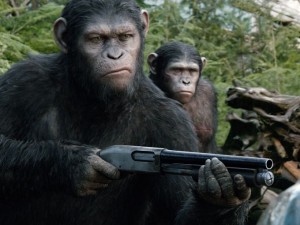 SYNOPSIS: Set ten years after Rise of the Planet of the Apes saw Caesar (Andy Serkis) break free from a San Fransisco primate sanctuary and start an ape uprising, the middle-aged chimpanzee is the leader of a large population of genetically evolved apes. Most of humankind was wiped out by a pandemic of ALZ-113—a “simian flu” virus that speeds up the rebuilding of brain cells in apes but is deadly to humans—but when a small band of humans scout a water source near the ape camp a monkey wrench is thrown into the fragile peace between homo sapiens and simians is threatened. “Apes do not want war,” says Caesar, but a battle—gorilla warfare?—for control is inevitable.
SYNOPSIS: Set ten years after Rise of the Planet of the Apes saw Caesar (Andy Serkis) break free from a San Fransisco primate sanctuary and start an ape uprising, the middle-aged chimpanzee is the leader of a large population of genetically evolved apes. Most of humankind was wiped out by a pandemic of ALZ-113—a “simian flu” virus that speeds up the rebuilding of brain cells in apes but is deadly to humans—but when a small band of humans scout a water source near the ape camp a monkey wrench is thrown into the fragile peace between homo sapiens and simians is threatened. “Apes do not want war,” says Caesar, but a battle—gorilla warfare?—for control is inevitable.
STAR RATINGS:
Richard: 4 ½ Stars
Mark: 4 Stars
Richard: Mark, to riff off of the old Superman tagline, “You will believe an ape can speak.” The special effects are amazing, but beyond the pixel manipulation that brings Caesar and company to vivid life, there are remarkable performances that, for lack of a better phrase, humanize the apes. These aren’t the erudite apes of the Roddy McDowell era, with vocabularies that would impress even Conrad Black, but simian characters that behave somewhere midway between pure instinct and higher intelligence. I went bananas for the apes. You?
Mark: The apes may have limited vocabularies but they’re a lot more interesting than the humans in the picture. This is a very sophisticated blockbuster that deals with our queasy relationship to the animal world and also acts as a metaphor for our need for civilized diplomacy. The post-apocalyptic world of a verdant but decaying San Francisco is visually plausible, and there are plot points worthy of a Greek tragedy. But enough about that. The apes are rad, man!
RC: It sure is a different kind of blockbuster. It has all the elements of the usual summer fare—it’s a sequel, things blow up and, if that wasn’t enough, also features an ape —but it takes risks. About half of it is done in ape sign language (with subtitles) and it’s not chock-a-block with action. Instead it takes time building characters and motivations so when the wild ape-on-human action begins it feels earned and it feels epic.
MB: Ape-on-human? What about the fabulous ape-on-ape action? Havent seen this kind of gritty action since the Bumfight videos of the Nineties. When these apes go at each other, it’s feral and primitive. WWF, take note! And the ape sign language forces them to act with their eyes, which reminded me of the power of old silent films. I didn’t need a bunch of clunky dialogue to know what these gorillas were thinking.
RC: I agree. I think this is the kind of performance that could convince the Academy to consider “motion capture” acting for inclusion in the Oscar acting categories. Beyond the performances though, is a thought-provoking movie about race, gun usage and xenophobia. Its masked in allegory and, well, a story about talking apes, but it touches on those hot button topics in an interesting way.
MB: What is missing from the movie is James Franco, who brought some lightness and offhand charm to the last Apes movie. The apes are so strong in these films that the movie needs some star charisma to balance it out. Nevertheless, we’ve come a long way away from Bedtime for Bonzo.
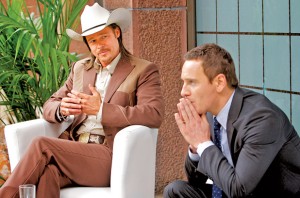 Cormac McCarthy may not be a household name around your place, unless you live with the Coen Brothers or maybe with the Pitt’s.
Cormac McCarthy may not be a household name around your place, unless you live with the Coen Brothers or maybe with the Pitt’s.
Literary critic Harold Bloom called the writer one of the four major American novelists of his time, and he has two all-star movies set for release, which may make his name a little more commonplace.
Later in 2013 James Franco directs, scripts and stars in Child of God, an adaptation of Cormac’s 1973 novel about, “a dispossessed, violent man whose life is a disastrous attempt to exist outside the social order.”
This weekend a star-studded cast lead by Brad Pitt, Cameron Diaz and Michael Fassbender headline The Counselor, directed by Ridley Scott.
Producer Steve Schwartz says the story of a lawyer in over his head after dipping his toe into the drug trade, “may be one of McCarthy’s most disturbing and powerful works.”
And that’s saying something about the writer who gave us a character like No Country for Old Men’s killing machine Anton Chigurh. Empire.com warned that when, “McCarthy throws “a dark character at you, it’s a safe assumption that you’re not going to be able to get them out of your head for a good, long while—if ever.”
As written by McCarthy and played by Javier Bardem, who earned an Academy Award for Best Supporting Actor for the part, Chigurh is merciless, a murderer who makes life and death decisions with the flip of a coin.
The Road—a 2007 Pulitzer Prize winner for fiction—is another disturbing McCarthy novel adapted for the big screen.
The story is simple. A man and his son (Viggo Mortenson and Kodi Smit-McPhee) try to survive in a dystopian world. Armed with only a gun and two bullets they must scavenge for food amid the ruins and protect themselves from cannibals who roam the desolate land.
The Road is a movie based on small moments set against a big backdrop. No parent will be able to forget the stark image of seeing a young boy who doesn’t know what a can of Coke is or a father teaching his son how to commit suicide.
It’s tough, no nonsense work from a writer who says he’s “not that big a fan of exotic foreign films,” especially movie with magical realism. “You know, it’s hard enough to get people to believe what you’re telling them without making it impossible,” he says. “It has to be vaguely plausible.”